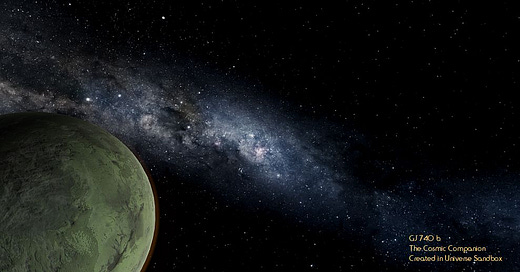Meet GJ 740 b - a Super-Earth Orbiting a Red Dwarf Star - The Cosmic Companion April 16, 2021
This super-Earth is no place to call home...
Astronomers found an exoplanet orbiting the red dwarf star GJ 740. This rocky world, GJ 740 b, is three times more massive than Earth.
A look at what GJ 740 b might look like. Image credit: The Cosmic Companion / Created in Universe Sandbox
Red dwarf stars are significantly cooler than our own sun, with surface temperatures between 2,100 and 3,400 degrees Celsius (3,860–6,200 Fahrenheit) — roughly 2,000 C cooler than our parent star. These diminutive, ruddy stars are also smaller than our sun, containing between eight and 45 percent as much mass as the Sun.
Sitting roughly 36 light years from Earth, the GJ 740 system could provide astronomers an intriguing target in the study of planets around alien worlds.
This newly-discovered exoplanet has a mass about three times greater than Earth, and orbits its star once every 2.4 days.
Read more: https://thecosmiccompanion.net/gj-740-b
AND - Take a look at Mars Friday and Saturday night, as the Red Planet huddles close to the Moon! We talk to Andrew Fazekas - National Geographic’s “Night Sky Guy” about how to see this display! Full interview April 20!
We have amazing guests coming up on Astronomy News with The Cosmic Companion!
THIS WEEK! April 13 (s4/e15): Affelia Wibisono of University College London, discussing the recent discovery of X-rays from Uranus.
April 20 (s4/e16): Andrew Fazekas, National Geographic’s “Night Sky Guy,” talking about his National Geographic Backyard Guide to the Night Sky.
Plus – just added - NASA’s Joshua Ravich, mechanical engineering lead for the Ingenuity helicopter on Mars.
April 27 (s4/e17): Ohad Harlev, CEO of Lyteloop, discussing new technology for storing data in space.
For more details on space and astronomy news, please visit: thecosmiccompanion.net or thecosmiccompanion.com.
Thanks for reading, donating, and sharing!
- James




